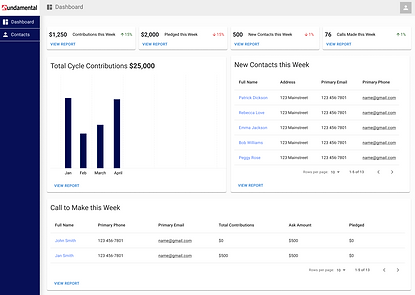A Case Study

Project Summary
My project aims to address the challenge faced by local political campaigns in managing donor relationships due to the high cost and steep learning curve of existing CRM solutions.
Political campaigns, whether at a national or local level, rely on building strong relationships with donors for success. However, the existing CRM solutions, with an entry point cost of $250 per month and complex features, often shut out local campaigns, which are already at a disadvantage due to limited resources. As a result, they lack access to effective donor management tools, making it challenging to compete against larger campaigns.
To solve this problem, we have developed a new CRM solution, Fundamental, designed explicitly for local political campaigns. Our solution provides an affordable and user-friendly platform that streamlines donor management, fundraising, and communication. It offers all the necessary features without the high price tag and complicated interface.
Fundamental is aimed at candidates, campaign staff, and grassroots volunteers involved in local political campaigns. It empowers them to build and manage strong donor relationships, communicate effectively with supporters, and run successful fundraising campaigns. Our solution ensures that local campaigns have access to the same tools as larger campaigns, leveling the playing field and increasing their chances of success.
Our project is committed to making a positive impact on local politics by providing affordable and accessible donor management tools to local campaigns. With Fundamental, we aim to help local campaigns thrive and promote democracy and civil discourse in our communities.
Design Process
2. Define
3. Ideate
4. Prototype
5. Test
1. Empathize

Tools Used
Figma, Adobe Illustrator, FlowMap, Maze
Role
UX/UI Designer
Duration
2 weeks
Empathize
Stage Summary
The Empathize stage of my project focused on gaining a comprehensive understanding of user needs and pain points. To achieve this, I conducted research guided by a user survey that reached out to political campaign professionals. We received 36 responses, which helped us identify the following research goals:
-
To learn about the most important features that users require in order to develop an MVP for testing.
-
To understand the needs of political campaign professionals, identify their pain points and uncover potential openings in the market.
By gathering this information, I aimed to develop a deeper understanding of the user's perspective and design a solution that meets their needs. The Empathize stage was an essential step in ensuring that our project is user-focused and relevant to the challenges faced by political campaign professionals.
Research Outcomes
Quantitative Data:
Our survey gathered quantitative data from 36 respondents in the political campaign industry. When asked about their role in the last election cycle they worked in, 52% of respondents worked in campaign management, 41% worked in campaign finance/fundraising, and 6% held other roles. Additionally, when asked if they had experience using the competitor's solution, 85% of respondents answered yes, while 15% answered no.'
Qualitative Data:
Our survey also gathered qualitative data, with respondents asked to name their top three most important features and describe their experience with the competitor's solution. The most frequently mentioned top three features were tracking donor contact, tracking donor history, and compliance/campaign finance reporting.
In terms of describing their experience with the competitor's solution, respondents used a range of terms such as "cumbersome", "affordability", "designed for experienced users", "feature rich", and "powerful tool with large knowledge base". These responses provided us with valuable insights into the strengths and weaknesses of the competitor's solution, as well as what features are most important to our target users.
Research Outcomes
Define
Stage Summary
Upon completion of data analysis, I proceeded to the define stage and developed two personas based on the identified roles during the initial stage.
Subsequently, I created a storyboard, outlining epics and tasks, and identified two critical tasks for the user flows.
User Personas
Based on research and user personas, I identified three epics and for each, wrote out various tasks that would fall under each.


User Stories
In the storyboard stage, I used insights from research and user personas to identify three epics and their corresponding tasks. Based on time constraints and the goal of creating an MVP, I selected the two most important tasks:
1. Creating an individual contact and
2. Importing a list of contacts from a file
These tasks guided the creation of all the necessary pages for the MVP.

User Flow 1: Import Contact from File

User Flow 2: Create a New Individual Contact

Ideate
Stage Summary
During the ideation stage, I began by sketching some rough ideas on paper before moving on to create a low-fidelity wireframe in Figma. My primary goal during this stage was to use the tasks and user flows identified in the previous stage to establish a solid foundation for the project. I also designed a logo and other branding elements in Adobe to give the project a cohesive visual identity.
Sketches


Wireframes




Branding

Prototype
Stage Summary
For the final prototype, I incorporated the branding developed in the previous stage, and improved the functionality based on the initial wireframes. Then, I proceeded to build a testable prototype for further testing and feedback.



Testing
Stage Summary
For the testing stage, I utilized Maize to conduct a usability testing survey which was completed by 22 participants. From the results, the following insights were discovered:
• There was an issue with the sizing of the add contact form on larger screens, causing the buttons at the bottom to be cut off.
• Roughly 50% of users had prior experience using a CRM.
• Some users mentioned that the plus icon in the top right corner was too small.
• Users predominantly used path 2 to add a new individual contact.
• The success rate of direct importing contacts was almost 100%.
Based on the insights gathered, the following corrections were made to the prototype:
• The issue with the buttons being cut off was corrected.
• The plus icon in the top right corner of the screen was enlarged for better accessibility.

